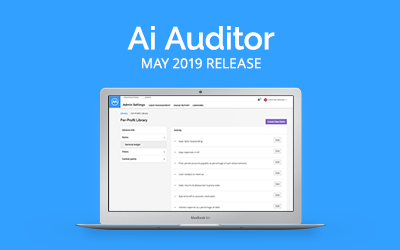Welcome to the “post-busy season” release of Ai Auditor, just in time for your Not-for-Profit audit engagements! Our new release of Ai Auditor includes a host of new features that enable more use cases, such as Accountant Reviews. This release includes several great features including:
Libraries: Contains all the business logic needed to perform analysis within a particular industry or market and allows you to customize analysis based on industry types with different ratios, filters, and Control Points.
Ratio Builder: Enables you to build and save ratios that are relevant to your clients and industry. Analyzing finances with these custom ratios can help you identify trends and other data that inform essential business decisions.
Not-for-profit: We have introduced not-for-profit (NFP) General Ledger analysis support, allowing you to perform financial analysis for NFPs with and without a fund-based structure (fund accounting).
Annotations and exporting analytics: Allows you to document and store insights gained during the planning of an audit or an analytical review to create supplementary documentation without the need for other tools.
Let’s dive deeper into each area.
Libraries
Do you make use of specific filters when you perform an audit for a healthcare client vs. a construction engagement? Do you have particular ratios that you track during the planning phase for different industries? Do you wish you could customize Ai Auditor based on an industry type with different ratios?
In this release, we’re introducing the concept of a Library. Libraries help you tailor the work done in Ai Auditor based on the industry that your client operates in. Libraries are used to manage and maintain the financial ratios needed for a specific type of analysis. In our next release, the ability to change filters and Control Points will be added to Libraries to simplify the selection of settings for different types of analysis. We’re making sure that you’re always doing the most relevant work possible so that you can differentiate your firm and drive profits. Libraries also allow you to reuse configurations across different users and departments within your firm.
An Administrator can create a new Library under the Libraries tab in the Admin section of Ai Auditor. Creating a library allows admins to define their own custom ratios, filters, or Control Point weighting so that you’re always seeing the right information.
To get you started, we’ve released two new NFP libraries along with the for-profit library, our original analysis type.When creating a new engagement, there is now a selection available in the engagement creation section where you can choose from the available Libraries. Choosing a Library selects the financial ratios that you’ll see in your analysis.You can construct and add ratios to Libraries. In this release, filters and Control Points will be read-only. In a future release, filters and Control Points will be included in Libraries for additions and configuration.
Through Libraries, you will find the right information at the right time, and this is a big step forward in helping you complete your work faster and with greater transparency.
Ratio builder
We recognized that the ratios presented were not always the most relevant for your client, and in many cases, alternate ratios or different types of calculations were required. Administrators now have the ability to define new ratios at the Library level. If, for example, the ratio of “Staff cost to Revenue” is particularly important for your client, we want to make sure that information is always at your fingertips.
When creating a ratio, users can select from any account or account level within the account structure, as well as specify different balance amounts such as the closing balance, opening balance, or the monthly movement. They can string together multiple accounts to create complex ratios, which can be saved for reuse in the Library.
Each custom ratio, as illustrated in the image below, contains a ratio name, a category (i.e., Activity, Profitability) and numerator and denominator for the ratio formula. Account amounts, specific values, and constants within the ratio builder can be included in ratio formulas. These values are displayed to the user for selection in the Add drop-down.When an engagement is created, a Library is selected from the list of available Libraries. The ratios corresponding to the Library, are made available on the Trending dashboard.
Not-for-profit support
NFP organizations are often complex, with restrictions in place that dictate the way they can spend and the way they handle income streams. NFPs can often be risky entities to audit and their books can be complicated and sometimes messy.
To support NFP analysis, we’ve updated our account grouping hierarchy to include NFP concepts such as contributions, pledges, grants, funds, and restricted and unrestricted net assets. You can leverage the new NFP-augmented account grouping through the selection of supplied Libraries.
To complement NFP analysis, we have added specific NFP-based ratios such as Liquid Funds Amount, and Defensive Interval, along with many more. With the new Ratio Builder feature, you’re also free to add your own as well.
With NFP analysis, we’ve also developed new Control Points to support specific types of industry analysis for NFP.
In this release, we’re providing two new libraries for NFP.
NFP Library
The NFP Library has an updated account grouping structure to suit NFP concepts such as contributions, grants, and new ratios specific to NFP, such as Operating Reserve, Change in Net Assets, and Operating Margin. We’ve also added a new Control Point that looks for abnormal amounts of expense activity.
NFP-Fund Library
The NFP-Fund Library supports fund-based accounting. If your client uses funds to separate accounts for tracking and reporting purposes, this is the Library to use.
This Library comes with an updated account grouping structure to suit NFP and fund concepts. When you create an engagement, you can choose this Library and upload an augmented Chart of Accounts (COA). For the fund-based NFP analysis, you are required to include a Fund ID and optional Fund Description column in your COA file.
Note that for a Wolters Kluwer CCH fund-based NFP analysis, Fund ID details will be ingested automatically from the CCH General Ledger file and do not need to be added to the COA file. When ingesting a CCH General Ledger file, Fund ID details will be pulled from the “Group” code in the CCH General Ledger file.
For fund-based NFP analysis, we’ve introduced several new Control Points, such as Fund Expense Flurry, Interfund Transfer, and Split Expense that offer quick and easy ways for you to identify transactions of interest in an NFP’s General Ledger.
Annotations and analytics export
This feature provides the ability for you to document and store insights observed during audit planning or analytical review to assist in getting that information into audit documentation without recreating in other tools.
As you are exploring trends and ratios, you can add annotations to each graph under the Trending tab. Annotations, graphs, and the underlying data can then be exported into Microsoft Excel for inclusion in final reports and papers.
In addition to having a list of annotations on each graph on the Trending tab, you can view a list of all annotations on the Annotations tab and filter by account to find all annotations related to an account as well as the corresponding charts and visualizations.
Conclusion
This release is driven by our philosophy that it’s important for auditors and accountants to both customize and automate what they are doing. By giving you the proper tools to create and organize, we’re setting the foundations for even more powerful features in the future!




